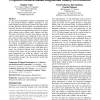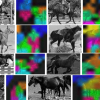746 search results - page 79 / 150 » A Neural Model of Human Object Recognition Development |
WSCG
2000
13 years 10 months ago
2000
In the Mixed Reality environment that combines the real world and the virtual world it is important to control the 'place' that comprises both real and virtual objects. ...
PRIMA
2009
Springer
14 years 3 months ago
2009
Springer
In recent years, the topic of emotion reading has increasingly received attention from researchers in Cognitive Science and Artificial Intelligence. To study this phenomenon, in th...
CHI
2005
ACM
14 years 9 months ago
2005
ACM
Are the object manipulation techniques traditionally used in head?mounted displays (HMDs) applicable to augmented reality based projection systems? This paper examines the differe...
ABIALS
2008
Springer
14 years 3 months ago
2008
Springer
Anticipation and prediction have been identified as key functions of many brain areas facilitating recognition, perception, and planning. In this chapter we present a hierarchical ...
CVPR
2010
IEEE
14 years 5 months ago
2010
IEEE
Object recognition is challenging due to high intra-class
variability caused, e.g., by articulation, viewpoint changes,
and partial occlusion. Successful methods need to strike a...


